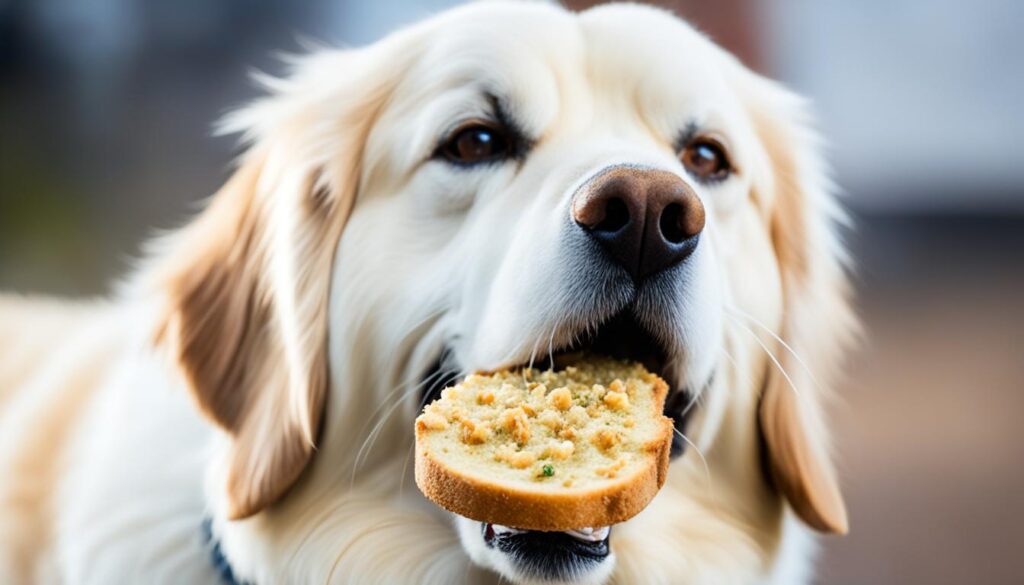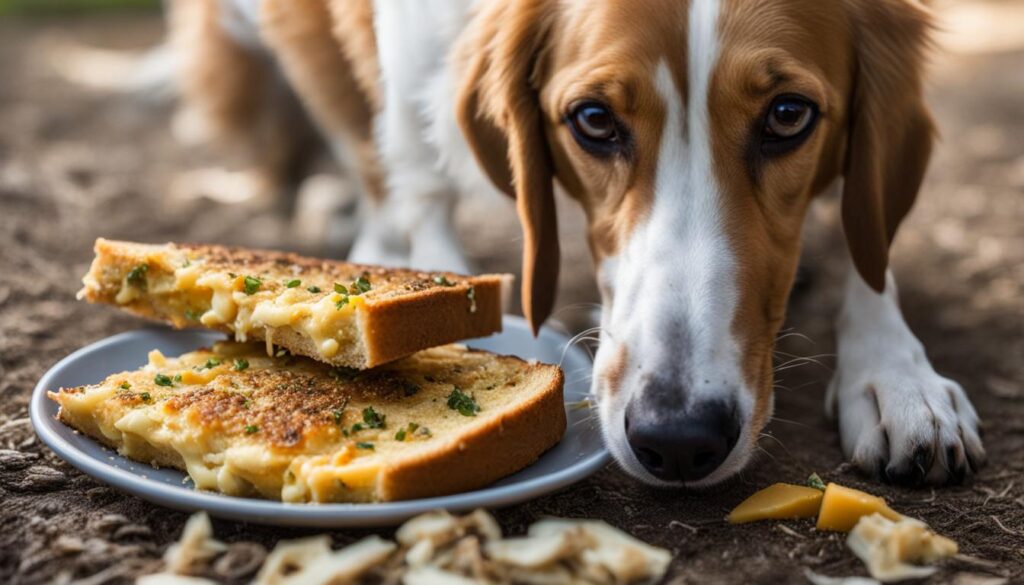Can Dogs Have Garlic Bread? Safety Guide & Tips
If you’re a dog owner, you may have wondered whether it’s safe to share your garlic bread with your furry friend. While it may be tempting to give them a taste of this delicious treat, it’s important to understand the potential risks involved.
Garlic and other members of the allium family, such as onions, contain a compound called thiosulfate, which is toxic to dogs but not to humans. Thiosulfate causes oxidative damage to red blood cells, leading to anemia. Ingesting garlic can have serious health consequences for dogs.
Although small accidental ingestion may not be harmful, intentionally feeding garlic to your dog is not recommended. Garlic bread also contains other ingredients like butter, oil, cheese, herbs, and seasonings that can upset your dog’s stomach and provide no nutritional benefits.
Key Takeaways:
- Garlic and other allium family members are toxic to dogs due to the compound thiosulfate.
- Ingesting garlic can cause anemia, gastrointestinal issues, and other health problems in dogs.
- Feeding garlic bread to your dog is not recommended as it contains additional ingredients that can be harmful.
- Opt for dog-friendly alternatives instead of garlic bread to ensure your dog’s health and well-being.
- If you suspect your dog has ingested garlic or is showing symptoms of garlic poisoning, seek veterinary care immediately.
Why is Garlic Bad for Dogs?
Garlic, with its pungent aroma and distinct flavor, may be a staple in many kitchens, but when it comes to dogs, it poses serious health risks. The compound responsible for the dangers of garlic for dogs is thiosulfate. This compound damages red blood cells in dogs, leading to a condition known as garlic toxicity or garlic poisoning. Unlike humans, dogs metabolize certain foods differently, which means that while garlic may have health benefits for us, it can be toxic to our canine companions.
Ingesting garlic can have detrimental effects on a dog’s health. One of the most significant impacts is the damage it causes to their red blood cells, leading to anemia. Symptoms of garlic toxicity in dogs vary but can include pale mucous membranes, rapid breathing, lethargy, weakness, jaundice, dark urine, vomiting, diarrhea, loss of appetite, abdominal pain, depression, and dehydration. It is essential to be aware that these symptoms may not manifest immediately and can take a few days to appear.
“Garlic is poisonous to dogs due to the compound called thiosulfate, which damages their red blood cells and can lead to anemia.”
If you suspect that your dog has ingested garlic or is showing symptoms of garlic poisoning, it is crucial to seek immediate veterinary care. A veterinarian can assess the severity of the situation and provide appropriate treatment to mitigate the harmful effects of garlic toxicity.
It’s important to remember that prevention is the best approach when it comes to garlic and dogs. Keep any garlic and garlic-infused foods, including seasonings and spices, out of your dog’s reach. If you’re cooking with garlic, make sure to keep an eye on your dog to prevent accidental ingestion.
“Prevention is the best approach when it comes to garlic and dogs. Keep any garlic and garlic-infused foods, including seasonings and spices, out of your dog’s reach.”
Now that you understand the risks of garlic for dogs, it’s essential to be vigilant and mindful of what you feed your furry friend. In the next section, we will discuss whether dogs can eat garlic bread and the potential hazards it poses.
Can Dogs Eat Garlic Bread?
Dogs should refrain from consuming garlic bread due to its potential harm to their health. While garlic itself is toxic to dogs, garlic bread also contains other ingredients like butter, oil, cheese, herbs, and seasonings that can be detrimental to their well-being. The consumption of garlic bread can lead to gastrointestinal upset, including vomiting and diarrhea, and its high fat and calorie content can contribute to obesity in dogs.
If you want to provide your dog with a treat, it is best to opt for dog-safe alternatives that are healthier and more suitable for their digestive system. There are numerous dog-friendly options available that can satisfy their cravings without posing any risks to their health.
“It is important to prioritize your dog’s well-being and steer clear from feeding them garlic bread. Opt for dog-safe alternatives that are both delicious and safe.”
Remember, as a responsible pet owner, it is crucial to prioritize your dog’s health and safety. Feeding them garlic bread can have adverse effects on their overall well-being. Instead, consider the following dog-friendly alternatives:
- Baked sweet potato slices: Sweet potatoes are a nutritious and safe alternative that dogs love. They provide essential vitamins and minerals while being gentle on their digestive system.
- Plain boiled or grilled chicken: Chicken is a lean source of protein that dogs enjoy. Ensure that it is cooked thoroughly without any seasoning or additives.
- Carrot sticks: Carrots are low in calories and high in fiber, making them a healthy option for dogs. They are also great for promoting dental health.
By avoiding garlic bread and choosing suitable alternatives, you can ensure that your dog stays happy and healthy.

Dogs and Garlic Bread: The Risks
Garlic bread poses several risks to dogs due to the presence of harmful ingredients and its potential to cause digestive issues. Here are some of the risks associated with dogs consuming garlic bread:
| Risks of Garlic Bread for Dogs | Potential Consequences |
|---|---|
| Gastrointestinal Upset | Eating garlic bread can lead to vomiting, diarrhea, and abdominal discomfort in dogs. |
| Obesity | The high fat and calorie content in garlic bread can contribute to weight gain and obesity in dogs. |
| Garlic Toxicity | Garlic contains compounds that are toxic to dogs, which can lead to anemia and other serious health issues. |
Considering these risks, it is advisable to avoid feeding garlic bread to your furry friend and to choose safer alternatives instead.
Health Risks of Garlic Bread for Dogs
Garlic bread poses several health risks to dogs. The most significant danger lies in the presence of thiosulfate, a compound found in garlic that can lead to thiosulfate poisoning in dogs. This condition can cause severe damage to their red blood cells and result in hemolytic anemia, a potentially fatal condition if left untreated.
In addition to the toxic effects of thiosulfate, garlic bread contains other ingredients that can be harmful to dogs. The high fat and calorie content in garlic bread can contribute to obesity, which in turn can lead to a range of health problems, including diabetes, heart disease, and joint issues.
The ingredients used in garlic bread, such as butter and oil, can also cause gastrointestinal issues in dogs. These can include vomiting, diarrhea, abdominal pain, and discomfort. Dogs have sensitive digestive systems, and rich, fatty foods like garlic bread can easily upset their stomachs.
It is crucial for dog owners to keep garlic bread away from their pets and provide them with a balanced diet that meets their nutritional needs. Opting for dog-friendly alternatives that are safe and nutritious is essential to ensure the overall health and well-being of dogs.
In conclusion, the health risks of garlic bread for dogs are significant. Thiosulfate toxicity, high fat and calorie content, and the potential for gastrointestinal issues make garlic bread an unsafe and unsuitable food for dogs. By understanding these risks and making informed dietary choices for our furry friends, we can ensure their long-term health and happiness.
Possible table:
| Health Risks of Garlic Bread for Dogs | Symptoms |
|---|---|
| Thiosulfate poisoning | Hemolytic anemia, pale mucous membranes, rapid breathing, weakness |
| High fat and calorie content | Obesity, diabetes, heart disease, joint issues |
| Other ingredients (butter, oil) | Gastrointestinal upset, vomiting, diarrhea, abdominal pain |

Conclusion
In conclusion, it is crucial to understand that dogs should not consume garlic bread or any food that contains garlic. Garlic is highly toxic to dogs, posing significant health risks such as anemia and gastrointestinal upset. To ensure the well-being and safety of your furry friend, it is best to avoid feeding them garlic bread.
Fortunately, there are plenty of dog-friendly alternatives to garlic bread that are both safe and nutritious. Consider offering your dog options such as plain cooked meats, vegetables like carrots or pumpkin, or specially formulated dog treats that are specifically designed to meet their dietary needs.
If you suspect that your dog has consumed garlic bread or is demonstrating symptoms of garlic poisoning, it is crucial to seek immediate veterinary care. Early intervention can make a significant difference in their recovery.
By being mindful of what you feed your dog, you can ensure their overall health and well-being. Remember, while garlic bread may be tempting to share with your furry companion, it is always better to prioritize their safety and explore alternative options that are more suitable for their dietary requirements.
FAQ
Can dogs have garlic bread?
No, dogs should not eat garlic bread. Garlic is toxic to dogs and can cause various health issues, including anemia and gastrointestinal upset. It is best to avoid feeding garlic bread to your dog and opt for dog-friendly alternatives.
Why is garlic bad for dogs?
Garlic contains a compound called thiosulfate, which is toxic to dogs. Thiosulfate can cause oxidative damage to red blood cells, leading to anemia. Ingesting garlic can also cause gastrointestinal issues in dogs, such as vomiting, diarrhea, and abdominal pain. It is important to keep garlic away from dogs and seek veterinary care if your dog has ingested it.
Can dogs eat garlic bread?
No, dogs should not eat garlic bread. Garlic bread contains not only garlic but also other ingredients like butter, oil, cheese, herbs, and seasonings that can be harmful to dogs. These ingredients can cause gastrointestinal upset and contribute to obesity in dogs. It is best to avoid feeding garlic bread to your dog and provide them with dog-safe alternatives.
What are the health risks of garlic bread for dogs?
Garlic bread poses several health risks to dogs. The thiosulfate in garlic can lead to serious conditions like hemolytic anemia. The high fat and calorie content in garlic bread can also contribute to obesity in dogs. Additionally, the other ingredients in garlic bread, such as butter and oil, can cause gastrointestinal issues. It is important to keep garlic bread away from dogs and provide them with a balanced diet that meets their nutritional needs.
Are there any alternatives to garlic bread for dogs?
Yes, there are several dog-friendly alternatives to garlic bread. Some options include plain bread without any toppings or seasonings, homemade dog biscuits or treats using dog-safe ingredients, and specially formulated dog-friendly bread or treats available in pet stores. It is important to choose alternatives that are safe and nutritious for your dog.


